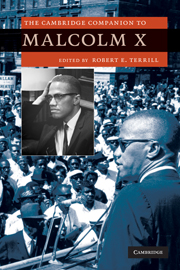Book contents
- Frontmatter
- Introduction
- 1 Malcolm X and Elijah Muhammad
- 2 Autobiography and identity: Malcolm X as author and hero
- 3 Bringing Malcolm X to Hollywood
- 4 Malcolm X and black masculinity in process
- 5 Womanizing Malcolm X
- 6 Malcolm X and the Black Arts Movement
- 7 Malcolm X and African American conservatism
- 8 Malcolm X and youth culture
- 9 Homo rhetoricus Afro-Americanus: Malcolm X and the “rhetorical ideal of life”
- 10 Judgment and critique in the rhetoric of Malcolm X
- 11 Nightmarish landscapes: geography and the dystopian writings of Malcolm X
- 12 Afrocentricity and Malcolm X
- 13 Malcolm X in global perspective
- 14 The legacy of Malcolm X
- Guide to further reading
- Index
3 - Bringing Malcolm X to Hollywood
Published online by Cambridge University Press: 28 May 2010
- Frontmatter
- Introduction
- 1 Malcolm X and Elijah Muhammad
- 2 Autobiography and identity: Malcolm X as author and hero
- 3 Bringing Malcolm X to Hollywood
- 4 Malcolm X and black masculinity in process
- 5 Womanizing Malcolm X
- 6 Malcolm X and the Black Arts Movement
- 7 Malcolm X and African American conservatism
- 8 Malcolm X and youth culture
- 9 Homo rhetoricus Afro-Americanus: Malcolm X and the “rhetorical ideal of life”
- 10 Judgment and critique in the rhetoric of Malcolm X
- 11 Nightmarish landscapes: geography and the dystopian writings of Malcolm X
- 12 Afrocentricity and Malcolm X
- 13 Malcolm X in global perspective
- 14 The legacy of Malcolm X
- Guide to further reading
- Index
Summary
Malcolm X's story hit cineplexes in 1992 as a biopic with a documentary inflected style. Framed in neon marquee lights, the Hollywood film prompted many to return to, or first encounter, the iconic racial spokesperson, both infamous and celebrated. The film was the latest installment of what scholars describe as the mythmaking enterprise of Malcolm X. It also provided a large-scale, familiar forum to consider the legacy of the American civil rights movement and its core debates between integration and racial autonomy. Indeed, the prospect of bringing Malcolm X to Hollywood ignited longstanding tensions between black nationalism and mainstream America, radicalism and respectability, and prophets and profitability. These tensions reflect problems of genre and visual culture, as much as biography and politics, because as Thomas Doherty avers, “For the young Malcolm Little, as for black Americans everywhere, the classical Hollywood screen was an inventory of negative stereotypes and a 35mm projection of white power.” The film, with its surrounding hype, became a platform for high-stakes scholarly and political discussions. The effort to bring Malcolm X to Hollywood had begun in 1968 when Columbia Pictures asked famed writer and civil rights spokesman James Baldwin to adapt The Autobiography of Malcolm X. Film producer Marvin Worth bought the story rights in 1967 from Alex Haley, the collaborator on the 1965 autobiography, and Betty Shabazz, Malcolm's widow.
- Type
- Chapter
- Information
- The Cambridge Companion to Malcolm X , pp. 39 - 50Publisher: Cambridge University PressPrint publication year: 2010



